Lachish
Lachish is part of the Shephelah, meaning "low land," so-called from the viewpoint of Judah's mountain dwellers. The Shephelah is the most excavated and least toured region in Israel, and as of this writing, groups rarely visit Lachish. That may change when the Visitors Center is ready (rest rooms!). Although the site has recently been laid out with paths and signs, there is still a feeling of untamed solitary majesty. The story is so rich that it's best to visit, if possible, when people are fresh. For the same reason, in reading these pages feel free to go first to the siege.
The historical geography
On the satellite map below, you can see that Lachish stood roughly midway between Ashkelon, the only port city in the area (Ashdod and Gaza being a bit inland), and Hebron in the highlands.
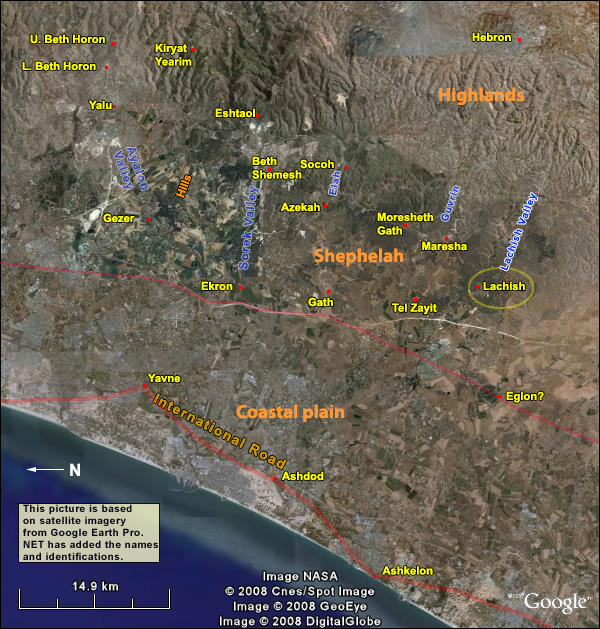
Like other Shephelah towns, Lachish was able to develop relations with the coastal cities on the west or with the highlands on the east (sometimes with both at once). [Note: If the green links don't work, try a different browser.] David Ussishkin,Ussishkin, D. 2004. "A Synopsis of the Stratigraphical, Chronological and Historical Issues," in Ussishkin, D. The Renewed Archaeological Excavations at Lachish (1973-1994) (Monograph Series of the Institute of Archaeology of Tel Aviv University No. 22). Tel Aviv: p. 56. who supervised the dig here from 1973 till 1994, found much evidence for a coastal connection in the years 1750-1550 BC (part of the Middle Bronze Age), namely cedar beams from Lebanon, shells from the Mediterranean and the Nile, also fish bones from both, and pottery from Cyprus. Again in the years 1300-1130 BC (the last part of the Late Bronze Age), "Lachish was a thriving Canaanite city-state maintaining strong connections with the Canaanite city-states in the Coastal Plain, and through them with other countries...." (Ussishkin).Ussishkin, D. 2004. "A Synopsis of the Stratigraphical, Chronological and Historical Issues," in Ussishkin, D. The Renewed Archaeological Excavations at Lachish (1973-1994). Tel Aviv: p. 93 There is no evidence, though, of contact between Late Bronze Lachish and the highlands to its east, which - archaeologically speaking - seem to have been almost empty of settlements then.
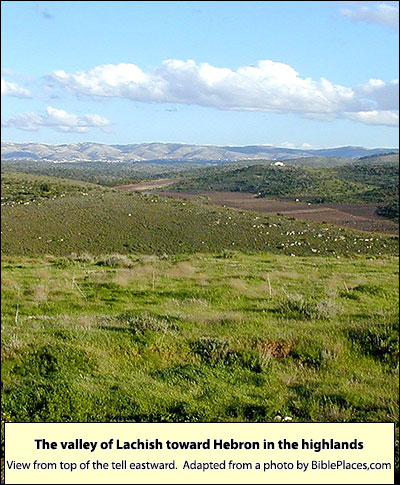
Late Bronze Lachish was destroyed, along with most other urban centers in Greece, Asia Minor, and the Levant, in the Great Upheaval of the 12th century. For the next 200 years it was a ghost town, and just a few thousand people lived in the Shephelah as a whole, while on the coast the new Philistine cities prospered. At some point however (the time is disputed), Judahites began descending from their mountain and settling the region, including Lachish. Distinctive pottery of the resettled Judahite highlands begins to appear at Shephelah sites: it was coated red and burnished to a shine in irregular patterns by hand. The region's population grew to 50,000 or more. As for Lachish, its Judahite version did an about face from the Late Bronze Canaanite city: The friendly contacts were now to the east and up the mountain (see photo on the right). Toward the west, Judahite Lachish was a fortress-city, set up to counter potential threats from the international road. Trade with the Philistine coastal cities like Ashkelon fell to nothing: Ussishkin found hardly any fish bones, molluscs, or coastal-style pottery for the 9th and 8th centuries at Lachish.
The maps of the Palestine Exploration Fund from 1879 (pre-automobile, pre-road-cutting machines) enable us to see how Lachish and the other Shephelah towns could turn east or west, to the mountain or the coast, exploiting the potential commercial link or sealing it off. This link consisted of valleys and unbroken ridges. The valleys posed too high a risk for an ascending army, but they provided peacetime passage. To catch the geography in detail, I show the link in two parts.
Western portion:
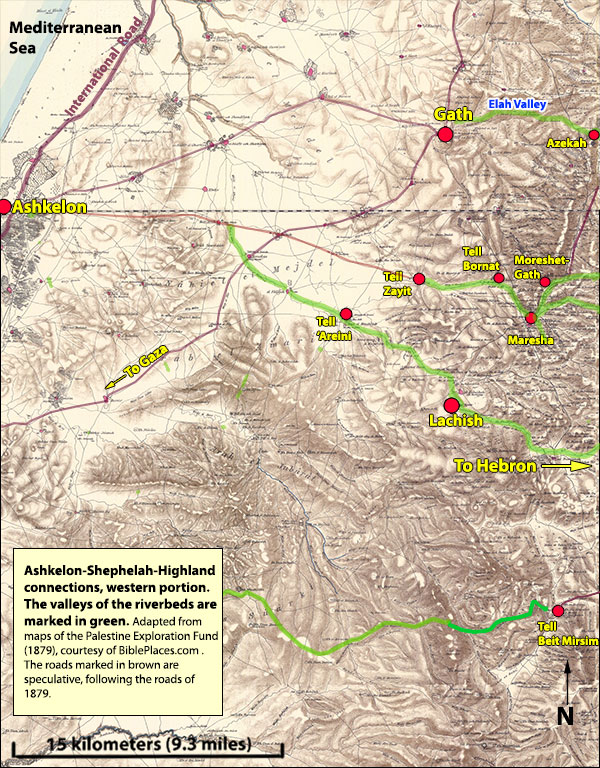
In the map above, notice Tell Zayit. I shall refer to it later.
Eastern portion:
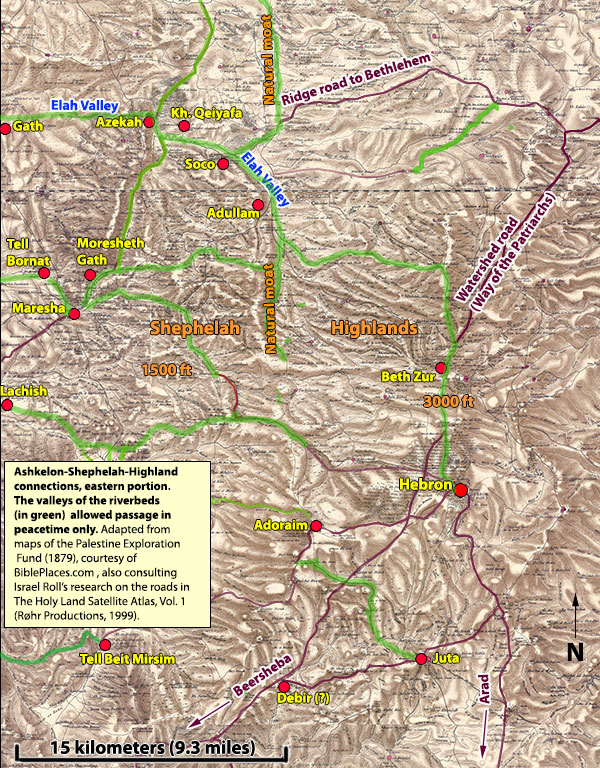
As a fortress-city, Lachish was the mightiest in Judah for most of that kingdom's history. Jerusalem, by contrast, does not seem to have had a wall in the 9th century (see the recent Givati excavations), while Lachish had two, upper and lower, not to mention its gate system and its palace-fortress (the biggest Iron Age edifice found in Israel).
The task of the Judahite fortress-city
What was the function of Lachish as a fortress-city? To defend Jerusalem? Yes, but not directly. As mentioned, an army attacking from the coast could not risk ascending through the valleys as long as there was highland opposition. Instead the attacker would have had to take one of only four ridges that weren't broken by a wadi. From north to south these were (1) the way through the Valley of Ayalon up the Beth Horon ridge, guarded by Gezer and, farther up, by the Beth Horons; (2) the way through the Sorek Valley and up a ridge, guarded by Beth Shemesh; (3) the way through the Valley of Elah up the ridge to Bethlehem, guarded by Azekah and Soco; and (4) the way through a wadi south of Lachish, via Tell Beit Mirsim (biblical identity unknown), up to Adoraim (Dura today) and thence five miles to Hebron. (For 3 and 4, see the P. E. F. map of the eastern portion above.) To repeat: Apart from these four routes there was no defensible ascent from the west. To the south and east of the mountain were desert buffers. Evil came from the north.
Of Lachish as a fortress-city, then, we can say this: Near its part of the international road, it had the function of preventing an enemy from penetrating the Shephelah and marching to one of the four ridges leading up. Just as important, though, was its task of protecting the Shephelah itself, for this made up around half the kingdom in the 9th and 8th centuries BC. It was chosen for its role as fortress, above the other Judahite cities in its area, because it triply outranked them in capacity: 18 acres compared with 6 or 7.
Other reasons why there was a city here
There were other factors too, apart from size and location, that explain why there was a city here. For one thing, the hill was well-proportionedIn general, before the Roman peace (pax romana), a city near a major road - hence near the flatland - needed a hill for defense. It had to be big enough to furnish an armed force but small enough so that the population supplied by its water source would suffice to produce enough soldiers to defend its wall. There had to be enough arable land to feed that population. Only certain hills fulfilled these requirements, and therefore people kept building on them. That is why we find layer after layer of ruins on some few hills, called tells, while other hills remained unsettled. in relation to demography, farmland, and water supply. The corners of the tell rise about 40 meters above the surrounding valleys (except at the southwest corner, where the Assyrians chose to attack: here a natural saddle reduces the height to 23 meters). Lachish was as well defended as many of the better known cities on the ancient international road. The surrounding hills hug in so closely, though, that we do not see its massive thrust until we are quite near. We round a bend and suddenly it looms above us.
As for farmland, Lachish had plenty (so-called Lachish grapes are the best in modern Israel). But as for water, this was a problem in the Shephelah. The entire region has no springs, because its surface limestone is waterproof; as a result, rainwater cannot percolate into the ground and collect there to gush out somewhere as a spring. Yet beneath the wadis (riverbeds), which are cuts in the limestone surface, water does collect, and along the east side of Lachish there stretches a wadi. We would expect the ancients to have dug a shaft reaching groundwater from inside the city, as they did elsewhere, but no such system has been discovered. There is in fact a shaft (25 by 22 meters and 22.5 meters deep), but it seems to have functioned only as a quarry for the city's building stones. At some unknown time, though, the inhabitants dug a well 44 meters deep on the upper part of the northeast slope. It was protected by the lower city wall (UssishkinUssishkin, D. 2004. "A Synopsis of the Stratigraphical, Chronological and Historical Issues," in Ussishkin, D. The Renewed Archaeological Excavations at Lachish (1973-1994) (Monograph Series of the Institute of Archaeology of Tel Aviv University No. 22). Tel Aviv: p. 80.).
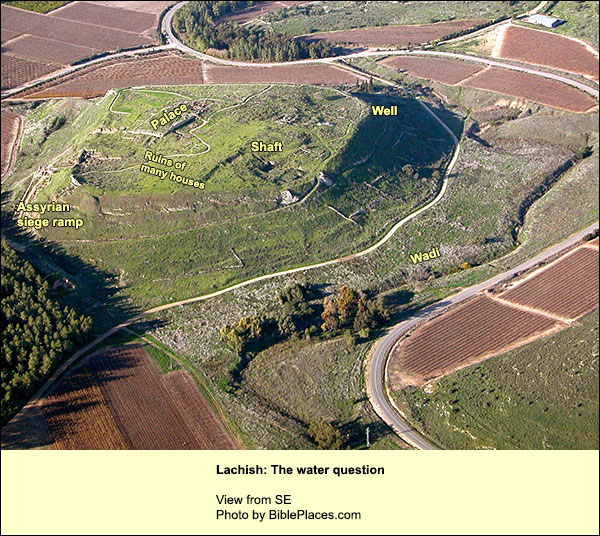
We shall now take a closer look at the history of Lachish, connecting it, where we can, with what can be seen at the site.
{mospagebreak title=Historical outline to 701 BC} Lachish until the Assyrian Conquest (701 BC) Lachish had its start in the 3d millennium BC, but most of what we see on site dates from the time of Judah (10th or 9th century BC until 701 BC, with a little from the early 6th).
The first large-scale settlement occurred in the latter half of the 3d millennium BC (Early Bronze III); the pottery indicates that even then there was trade with Anatolia (Turkey today). This city lasted a few centuries. We do not know why it vanished. There are no signs of fire.
In the time of the Hyksos
Around 1700 BC, in the HyksosIn the 18th and 17th centuries BC, Canaanites settled massively in the eastern Nile delta, eventually seizing dominion over lower Egypt. The Egyptians called them "Hyksos" ("foreign rulers") – and managed to throw them out after a century. The ceramic remains, scarabs and weapons at the Hyksos capital of Avaris (biblical Zoan) are very similar to those found in contemporary Canaanite sites. In the century before this Canaanite conquest of lower Egypt, the major cities in Canaan received massive systems of fortification, including huge earthen ramparts, which gave many of the tells the shape they hold to the present day. period, a new Lachish arose on the hill, surrounded by a steep artificial slope. This glacis was made by layering soil and small stones and coating the slope with lime plaster. A moat was dug on the west side (and maybe all around the hill - we don't know). At this time fortified cities were cropping up throughout the land, their ramparts giving them the upside-down-cupcake shape that has lasted till today. When the Egyptians expelled their Hyksos overlords in 1550 BC, they invaded Canaan and destroyed many of these towns, including Lachish.
Late Bronze Lachish (1550 - 1130 BC)
The Egyptian occupation of Canaan became entrenched after Pharaoh Thutmosis III defeated a league of 119 Canaanite city-states at Megiddo around 1468 BC. It appears that, wary of rebellions, Egypt did not allow its Canaanite subjects to build city walls. No trace of one has been found at Lachish. Oddly, a temple was erected in the western moat. Twice rebuilt, this "fosse temple" yielded many finds, now at the Rockefeller Museum in Jerusalem. The ruins of the building were deliberately covered by the archaeologists, so they are not to be seen.
Initially, the fosse temple stood alone. A city developed on the tell above in the first half of the 14th century, the time of the Amarna letters,In 1887 a peasant woman at el-Amarna in Egypt discovered 379 clay tablets in the ruins of the Pharaoh Ikhnaton's palace. These included letters in Akkadian from princes of city-states in the land of the Bible, such as Megiddo and Jerusalem, as well as some from Babylonia and Assyria. Written in the 14th century BC, they convey an impression of unstable conditions in the land at that time in which Lachish appears.
Under Egypt's protection and control, Lachish prospered in the late 13th and 12th centuries. Buildings covered the summit and spread down the slopes. In its wider orbit were 25 sites, so we can talk about as many as 6000 people in the city and its territory. "It appears that Lachish was one of the largest Canaanite cities in the land during the period" (Ussishkin,)Ussishkin, D. 2004. "A Synopsis of the Stratigraphical, Chronological and Historical Issues," in Ussishkin, D. The Renewed Archaeological Excavations at Lachish (1973-1994) (Monograph Series of the Institute of Archaeology of Tel Aviv University No. 22). Tel Aviv, p. 60.. It traded - via the port at Ashkelon - with the whole eastern Mediterranean world. Ussishkin found items that originated in Egypt, Anatolia, Mycenae, Crete, Syria, and Lebanon. It suffered a bad fire in 1200 BC but was then rebuilt in an even grander style. The renewed city - distinguished by Ussishkin as Level VI - had an Egyptian-style temple in its center, apparently part of a royal acropolis.
While Late Bronze Lachish was prospering, however, the perpetrators of the Great Upheaval were wiping out urban centers in a line of devastation spreading from Greece to Anatolia and southward through the Levant, reaching Hazor (destr. ca. 1230 BC) and Megiddo. A statue base turned up at Megiddo containing the name of Pharaoh Rameses VI, which indicates that the Egyptians managed to hold on there until his time, ca. 1130 BC. They probably also held on at Lachish, which stands between Megiddo and Egypt (although the last Egyptian find at Lachish is a scarab from 1150 or so). Impoverished and pressured by the Sea Peoples, especially the Philistines, Egypt at last retreated from Canaan, abandoning its protegé cities to their fates. Megiddo succumbed, followed by the Canaanite coast and Lachish.
Lachish and the chronology debate
Now, suppose we date the Philistine entry into the land at around 1200 BC, as is customary. In that case, the presence of the Philistines on the coast would overlap the existence of Lachish for about 70 years, so we would expect to find Philistine pottery in its ruins: at least the distinctive Monochrome pottery, if not the subsequent Bichrome. But not one Philistine sherd has turned up.
"Bichrome pottery has been found at sites even further inland than Tel Lachish.... Considering the geographical position, size, trade connections and prosperity of Lachish Level VI [the last Late Bronze city - SL], it is difficult to imagine that the nearby prosperous Philistine cities could have coexisted with Lachish at a time when Philistine pottery was being diffused inland from the coastal region without an appreciable quantity of it reaching Lachish. Can it be imagined that supplies of fresh marine fish were regularly brought from the coast of Ashkelon to Lachish but not a single Philistine [pottery] vessel found its way there....[T]he negative evidence from Lachish is so absolutely negative that it constitutes a sound argument for dating the appearance of Philistine Monochrome and Bichrome pottery anywhere in the country to after the destruction of Level VI in ca. 1130 BCE" (Ussishkin)Ussishkin, D. 2004. "A Synopsis of the Stratigraphical, Chronological and Historical Issues," in Ussishkin, D. The Renewed Archaeological Excavations at Lachish (1973-1994) (Monograph Series of the Institute of Archaeology of Tel Aviv University No. 22). Tel Aviv, p. 73. (my italics - SL).
Ussishkin is saying, in other words, that no Philistine pottery has turned up at Lachish because Lachish no longer existed when the Philistines arrived. On the grounds mentioned earlier, we can date the destruction of Lachish to 1130 BC. The significance is that "anywhere in the country," archaeological strata containing Philistine pottery must be dated after 1130 - and not after 1200 as previously thought. This conclusion is one of two considerations that led archaeologist Israel Finkelstein to propose the so-called Low Chronology:The first consideration is the cascading effect that you get when you lower the dates of Philistine pottery. The second is what you get by re-examining the stratigraphy of key sites from the period: Megiddo, Jezreel, Beth Shean, Lachish, Arad and Beersheba.
The Ussishkin-Finkelstein proposal has touched off a debate that lasts to the present day (2018). It affects the question of the United Monarchy under David and Solomon, for if we lower the date for the appearance of Philistine Monochrome pottery to 1130 BC, the effect is to lower the dates for all the strata that came afterward. This "snowball effect" leaves the 10th century, the century of David and Solomon, without monumental architecture at all - that is, without indications of a kingdom. The first monumental building occurs in the 9th century, at the time of a different father-and-son pair, Omri and Ahab of Samaria. The Low Chronology nourishes the suspicion that the biblical United Monarchy was a propoganda myth concocted at the time of Josiah (late 7th century) as part of an attempt to forge a unified nation out of Judah and refugees from the defeated Northern Kingdom. Tour groups find themselves caught in the crossfire between feuding scholars hurling Carbon 14. I shall not discuss the Chronology Question here; for examples of the opposing views see pieces by Finkelstein with Eli PiasetzkyIsrael Finkelstein and Eli Piasetzky, "The Iron Age chronology debate: Is the gap narrowing?" Near Eastern Archaeology, Vol. 74, No. 1 (March 2011), pp. 50-54. and, in support of a Modified Conventional Chronology, Amihai Mazar.Amihai Mazar, "The debate over the chronology of the Iron Age in the Southern Levant," in T. E. Levy and T. Higham (Eds.), The Bible and radiocarbon dating: Archaeology, text and science. Routledge, 2005. pp. 13-28. Let me mention one point, though, in response to the observation about the absence of Philistine pottery at Late Bronze Lachish: "Tel Miqne VII (Ekron) has produced vast quantities of Philistine monochrome pottery, while contemporary Stratum XIII at Gezer - 7 miles away as the crow flies - has not produced a single [Philistine] sherd in twenty seasons of excavations" (Dever)William G. Dever, Beyond the texts: An archaeological portrait of ancient Israel and Judah, SBL Press, 2017, p. 262. Yet all agree that Ekron and Gezer both existed during the period in question, namely, the very late 12th century (enlarge the map above on the right). We move to another question: Who destroyed Late Bronze Lachish? During the Great Upheaval there were peoples on the move, among them Israelites and Sea Peoples, including Philistines. In Joshua 10: 31-32, we read:"Joshua passed from Libnah, and all Israel with him, to Lachish, and encamped against it, and fought against it. Yahweh delivered Lachish into the hand of Israel. He took it on the second day, and struck it with the edge of the sword, with all the souls who were in it, according to all that he had done to Libnah."
Joshua is also said to have destroyed Hazor (Joshua 11: 10-11), which was burned and leveled, most agree, around 1230 BC. The idea that Joshua's campaigns lasted a century doesn't fit the biblical impression of a sudden Israelite conquest. Admitting the lack of direct evidence, Ussishkin espouses the notion that it was the "Sea Peoples" - a term which includes the Philistines themselves - who destroyed Lachish and left it empty for 200 years (Ussishkin)Ussishkin, D. 2004. "A Synopsis of the Stratigraphical, Chronological and Historical Issues," in Ussishkin, D. The Renewed Archaeological Excavations at Lachish (1973-1994) (Monograph Series of the Institute of Archaeology of Tel Aviv University No. 22). Tel Aviv, p. 71-72.
City of Judah
We have no direct evidence about when Lachish became Judahite. According to 2 Chronicles (11: 5-11), King Rehoboam, son of Solomon, built up fortress-cities for Judah's defense. The list includes Lachish. By the standard reckoning, that would put it in the late 10th century BC. Archaeologically speaking, though, some cities in the same list reveal no trace of fortification until much later and at least one (Beth Zur) was uninhabited. True, the first settlement to appear at Lachish after the end of the Late Bronze city was indeed Judahite, for it shows the distinctive pottery typical to Judah's mountain (red slip, irregular burnish). But the settlement was not fortified. On its periphery, Ussishkin found a house where a wall should have been. Of course, there may have been a belt of joined houses protecting the city, as at Arad in its pre-fortress Judahite period. The fact is, though, very little can be said about this first Judahite stratum, Level V. Its pottery can hardly be distinguishedUssishkin, D. 2004. "A Synopsis of the Stratigraphical, Chronological and Historical Issues," in Ussishkin, D. The Renewed Archaeological Excavations at Lachish (1973-1994) (Monograph Series of the Institute of Archaeology of Tel Aviv University No. 22). Tel Aviv, p. 78 from that of the fortress-city which succeeded it (Level IV), and it shows no architecture, except perhaps the podium of a palace that became bigger in Level IV, and perhaps a room with cultic objects.
We have then no direct evidence. However, a mere 7 kilometers north-northwest of Lachish, roughly halfway to the Philistine city of Gath, was Tell Zayit (enlarge the map on the right), excavated by Ron TappyTappy, R. E. et al., "An abecedary of the mid-tenth century B. C. E, from the Judaean Shephelah," Bulletin of the American Schools of Oriental Research, Number 344, November 2006, pp. 5-46. from 1999 through 2005. Its biblical identification is uncertain, but it may have been Libnah"When the [Assyrian] field commander heard that the king of Assyria had left Lachish, he withdrew [from Jerusalem] and found the king fighting against Libnah." 2 Kings 19:8 (the other candidate for Libnah is Tell Bornat to its east). Tappy found well-sealed strata, including the typical Judahite pottery and surviving parts of rock walls. "Comparative stratigraphic and ceramic analyses, radiocarbon dating, and reasonable historical reckoning" (Tappy)Tappy, R. "The Depositional History of Iron Age Tel Zayit: A Response to Finkelstein, Sass, and Singer-Avitz," Eretz-Israel, Vol. 30, Jerusalem 2011, p. 130 enabled him to associate a particular destruction layer with Sennacherib's invasion (701 BC) and a deeper one with the conquests of HazaelAn Aramean king who usurped the Assyrian throne in 840 or so and made widespread conquests which are evident in destruction layers at many sites, including Dan, Hazor and Gath. See 2 Kings 10:32; 2 Kings 12: 17-18 around 835 BC. Beneath this stratum Tappy found more well-defined strata, including a destruction level attributable perhaps to Pharaoh Shishak (Shoshenq I) around 925 BCIt is thought that the biblical Shishak (1 Kings 14:25, 2 Chronicles 12:1-9) was Pharaoh Shoshenq I (reigned ca. 943-922), who left an inscription lisitng cities he had conquered in the land. The part of the inscription pertaining to Judah is not well preserved, but here and in tells throughout the country, destruction layers appear that seem attributable to him.. (His date depends on both Egyptian and biblical records; we know of no one else who conquered cities in the land in the late 10th century.) Tappy points to evidence that the destroyed city had been defended by a belt of houses whose outer wall included large standing stones, regularly spaced. Beneath the destruction layer, hence older, was a layer still containing the typical Judahite pottery. (It sat directly on the last of the Late Bronze cities; as at Lachish, no one seems to have lived here in the the 11th century BC and part of the 10th.) Tappy feels confident in dating the first Judahite layer to the 10th century prior to Shishak, and to it he attributes a 22-letter, proto-Hebraic abecedaryThe written alphabet inscribed in a boulder that had been recycled in a wall (which he dates to the late 10th). Since the pottery at this clearly 10th century level is very like that in Lachish Level V, Tell Zayit provides indirect evidence that the latter was likewise from the 10th century.
[Update, October 2019: In quest of direct evidence, Yosef Garfinkel and his colleaguesLachish fortifications and state formation in the Biblical kingdom of Judah in light of radiometric datings. Radiocarbon. DOI: 10.1017/RDC.2019.5 dug at Lachish for five seasons (2013-2017). The north edge of the mound had never been excavated, and here they discovered a succession of walls. The oldest is three meters thick - enough to be called a fortification. On a floor abutting it, four olive pits were found. Radiocarbon dating of the pits indicates that the floor and hence the wall go back to 920 BC or so. Pillared houses adjoining the wall, writes Garfinkel, resemble those at Khirbet Qeiyafa, which he also dug, and which he identifies as built by Judah. His conclusion: Judah built a fortified city at Lachish in the late 10th century, a date that would fit the claim in 2 Chronicles 11:9 that Solomon's son Rehoboam erected a series of fortress cities, Lachish among them. In criticism, Nadav Na'amanNir Hasson. Did the kingdom of David exist? Haaretz, April 24, 2019. of Tel Aviv University notes that, judging from archaeology, other cities credited to Rehoboam in the list did not exist at the time. Na'aman also questions Garfinkel's identification of Qeiyafa as Judahite, saying it could be Canaanite or Philistine. That could also hold for the newly discovered wall at Lachish.
According to Garfinkel, his excavations at the short-lived Judahite sites of Khirbet Qeiyafa and Khirbet al-Ra'i (which is very close to Lachish) indicate earlier, failed attempts by Judah to expand from its mountain down into the Shephelah. The nearby Philistine city of Gath, huge and powerful, would have stopped such ventures. If he is right about Lachish, then its fortification in 920 and subsequent survival would signify a remarkable achievement for Judah, because Gath remained a great power until it was destroyed by Hazael around 835 BC. Na'aman suggests that the 10th-century wall at Lachish may have been built by Gath, not Judah. But that idea presents another problem: Surely Gath would have had the means to include the mound's entire plateau within its wall, as well as the soldier-power to defend it. In fact, however, the wall embraced only half the plateau, the part where earlier excavators did not dig. End of update.]
Sometime in the 9th century BC, Judah fortified Lachish with two concentric walls that did indeed surround all 18 acres, as well as a huge gate system on the western edge. Some reckon that this could not have occurred until after Gath's demise. If they are right, then it must have happened very soon after (perhaps with Hazael's agreement), because the pottery"Gath, Lachish and Jerusalem in the 9th Cent. B.C.E.– An Archaeological Reassessment," Zeitschrift des Deutschen Palaestina-Vereins, 131 (2015) 2, p. 138 found in the first stratum of the double-walled city resembles the pottery used at Gath before Hazael destroyed it.The 9th-century Lachish "was planned and built as a central fortress-city in the Kingdom of Judah. The scale of monumental construction and the massiveness of the fortifications are unprecedented in this period. Both the Palace-Fort and the city-gate are among the largest and most massive structures of this kind uncovered so far in the Land of Israel during the biblical period." (Ussishkin,"Gath, Lachish and Jerusalem in the 9th Cent. B.C.E.– An Archaeological Reassessment," Zeitschrift des Deutschen Palaestina-Vereins, 131 (2015) 2, p. 135.) Lachish "was the main military center of the kings of Judah" (ibid.). By contrast, as said before, Jerusalem did not even have a wall at the time.
To the Lachish of Level IV fled the Judahite king Amaziah (797-779), who sought refuge when his subjects rose against him:
"They made a conspiracy against him in Jerusalem; and he fled to Lachish: but they sent after him to Lachish, and killed him there" (2 Kings 14:19).
It was probably some time after this that the Level IV city was destroyed. We do not know when or why, but there are no signs of a city-wide fire. The earthquake in the days of Uzziah (Amos 1:1), around 760 BC, is mentioned as a possible cause. (Signs of earthquake from around this time have appeared in the dig at Tel Zayit and elsewhere.) Lachish was soon rebuilt according to the same pattern as in Level IV. Thus we arrive at Level III, which is identified by Ussishkin as the city that faced Sennacherib. The identification is not written in stoneFor the uncertainties, see Peter James, "Review of David Ussishkin: The Renewed Excavations at Lachish (1973–1994). 2004. Five vols. Emery and Claire Yass Publications in Archaeology, Tel Aviv." Palestine Exploration Quarterly, 139, 3 (2007), pp. 213–230, but only through it can we connect the historically known conquerors of Judahite Lachish with its archaeologically known destruction layers: Sennacherib must have destroyed Level III, because there is only one destruction layer after that (Level II), and we may deduce who did it from the following: "Then Jeremiah the prophet told all this to Zedekiah king of Judah, in Jerusalem, while the army of the king of Babylon was fighting against Jerusalem and the other cities of Judah that were still holding out—Lachish and Azekah. These were the only fortified cities left in Judah." (Jeremiah 34: 6-7) We shall look at the main features of Levels III and II in the section called "Tour of the Tell."To continue with the history: In 735 BC, the Assyrians invaded the Northern Kingdom ("Israel"). A few years later, the north refused to pay tribute, and sometime between 723 and 721, Assyria invaded again. This time it exiled the north's upper classes and resettled foreigners in their place. It was Assyrian policy to divide and scatter conquered peoples in order to break group identities, lessening the chances of revolt. That is what happened to the northerners, the "ten lost tribes." Yet many of them escaped the Assyrian net, fleeing south to the Shephelah and Jerusalem, both of which underwent huge surges in population.For supporting citations, see Israel Finkelstein, The Forgotten Kingdom, Atlanta: Society of Biblical Literature, 2013, p. 154 The Assyrians did not press south at this stage. Hezekiah was then in his sixth regnal year (2 Kings 18:10).
Twenty years later came the cue to revolt: In 705 BC. Sargon II of Assyria died. His son and successor was Sennacherib. Testing the new king, rebel groups arose in Babylon. Basing herself on Assyrian texts as well as the Bible (2 Kings 18-19), archaeologist Norma FranklinThe Kushite connection: The destruction of Lachish and the salvation of Jerusalem, in Tell it in Gath: Studies in the History and Archaeology of Israel. Muenster: Zaphon, 2018. reconstructs the rest of the story as follows. Taking advantage of Sennacherib's problems, Egypt decided to reestablish itself in the Levant. Its army marched north, allying with Ashkelon and Hezekiah king of Judah. Egypt was ruled by a Cushite dynasty, the 25th - that is, by black Africans whose base was in the Upper Nile. (Unfortunately, their historical records have not come down to us.) The Cushites engaged Sennacherib in battle at Eltekeh (perhaps near today's Israeli town of Rehovot). The Cushite general was a prince named Taharqo (Tirhakah in 2 Kings 19:9), but he and his forces were thrown back. Sennacherib and his Assyrian army then proceeded to conquer and devastate the Shephelah, including its strongest fortress city, Lachish. Franklin suggests that there were Cushites defending Lachish as well as Judahites, and - on the basis of the way captives are differentiated in the Lachish reliefs - that the Cushites were horribly punished, whereas the Judahites were exiled to Assyria. Sennacheriib then sent three of his commanders and their forces to besiege Jerusalem and compel Hezekiah's surrender. In the midst of this attempt, however, Taharqo/Tirhaka again set off from Egypt toward the Assyrian army: "Now Sennacherib received a report that Tirhakah, the king of Cush, was marching out to fight against him" (2 Kings 19: 9; in fact, Tirhakah did not become king until 10 years later.) According to 2 Kings 19:35, the angel of the Lord then slayed 185,000 of the Assyrian army, and Sennacherib returned to Assyria. Franklin raises another possibility: On hearing of the renewed Cushite attack, the three Assyrian commanders that were besieging Jerusalem hurried back to the Shephelah to reinforce their king. On Franklin's interpretation, then, the Cushites in effect saved Jerusalem!
There is a curious finale in the form of an account from the Greek historian, Herodotus. It takes place at Pelusium on the road to the Nile delta. Herodotus (Hist. 2.141) reports that mice, the Greek symbol for plague, “gnawed quivers and bows and the handles of shields,” forcing the Assyrians to go home. It may be that, while pursuing the Cushites, the Assyrians were smitten by plague in Egypt (a common hazard there, as Napoleon would discover).
The biblical account begins at what seems to be the end of the story, on a brief and brutal note (2 Kings 18:13-16):
"Now in the fourteenth year of King Hezekiah, Sennacherib king of Assyria came up against all the fortified cities of Judah, and took them. Hezekiah king of Judah sent to the king of Assyria to Lachish, saying, “I have offended; return from me. That which you put on me, I will bear.” The king of Assyria appointed to Hezekiah king of Judah three hundred talents of silver and thirty talents of gold. Hezekiah gave him all the silver that was found in the house of Yahweh, and in the treasures of the king’s house. At that time, Hezekiah cut off the gold from the doors of Yahweh’s temple, and from the pillars which Hezekiah king of Judah had overlaid, and gave it to the king of Assyria."
(Note the date: the "fourteenth year of King Hezekiah." That would have been around 715 BC, when Sennacherib was still crown prince, not king. Moreover, Assyrian records show only one campaign by him into Judah - in 701. Assyrian dates for this period are reliable.) The very next verses (2 Kings 18: 17 – 19:37) give an entirely different impression. As we have just seen, Sennacherib's commanders came up from Lachish to Jerusalem and threatened it. But in the Biblical account, Hezekiah prayed to Yahweh, and Jerusalem was miraculously delivered. This sequence includes no mention of tribute. It would hardly be a victory for Yahweh to strip the doors of His temple!
Stepping back in time: Hezekiah's preparations
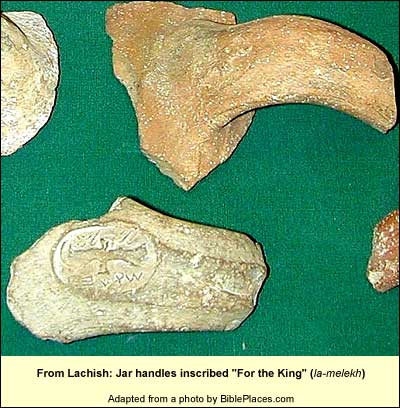
Hezekiah made extensive preparations for the revolt. The most famous archaeological evidence of these is the tunnel by which he secured the water supply in Jerusalem. He also expanded the capital to accommodate 20,000 people, surrounding the new addition with a wall.
Knowing that his towns would be under siege, Hezekiah gathered grain, wine and oil in large jars made of Shephelah clay, which bore the stamp "For the King,"Throughout the territory of Judah, archaeologists have discovered hundreds of jar handles bearing the inscription, "For the King" (la-melekh), followed by the name Hebron or Soco or Zif or Mamshit. All were made of the same kind of clay, probably in one place. Some bear the image of a scarab, others of the sun with wings. Most of those discovered date from Hezekiah's reign. Grain, wine and oil would have been collected at the four named places, then packed in the jars and distributed. (la-melekh). At Lachish, in the destruction layer of Level III, pieces of these jars turned up in practically every room. More "For the king" handles were found here than in all other sites combined: 489 la-melekh stamps plus 90 bearing names of individuals. Most have the name "Hebron" (Ussishkin,David Ussishkin, "Lachish," The New Encyclopedia of Archaeological Excavations in the Holy Land, Jerusalem, 1993p. 909), which was probably the distribution center for the contents of the jars.
Let us now take a close look at the battle.
{mospagebreak title=The Siege}
The Assyrian Siege of Lachish When we drive into the site and descend from the bus, the first thing we see is the most dramatic find of all: the remains of an assault ramp at the southwest corner of the tell. The drama is heightened by the fact that an Assyrian artist recorded his king's conquest in stone reliefs. After the victory over Judah, Sennacherib had a palace built (by exiled Judahite workers?) at his capital in Nineveh, and he lined one side of a large hall - his throne room, perhaps - with the Lachish reliefs. The British discovered them around 1850, cut them into strips, and shipped them to the British Museum in London, where they take up 18 meters of wall. The Israel Museum in Jerusalem has a partial copy, and there will soon be another, it is hoped, in the Lachish Visitors Center which is now being built.
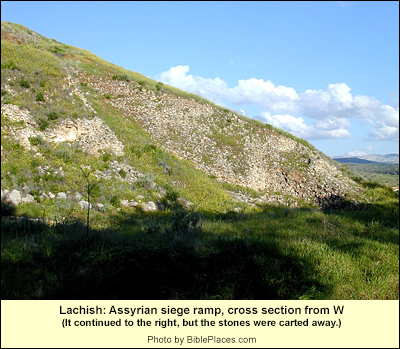
On site, when we emerge from the trees, we are so close to the ramp that it is easily missed. The British archaeologist J. L. Starkey, who dug here in the 1930's, saw what resembled a big bulge in the side of the hill almost reaching the top. He mistook the stones inside the bulge for masonry that had collapsed from above during the intensest part of the battle. He had most of them carted away while clearing the face of the city's lower wall. Starkey was murderedThis happened in 1938, the time of the Arab Revolt against British rule in Palestine, but the particular motive may have been a dispute over the summit of Tell Lachish: The British Mandatory government had expropriated it to enable the excavation, without compensating the owners. See Yosef Garfinkel, "The murder of James Leslie Starkey near Lachish," Palestine Exploration Quarterly,148, 2 (2016), pp. 84-109. before he could remove it all, and you can see the surviving part in the photo. It contains masses of uncut fieldstones, at least 13,000 tons of them. Visiting in 1973, the first year of the renewed excavations under David Ussishkin, Yigal Yadin (who had excavated Masada with its Roman assault ramp) remarked that if these stones came from the city walls, one would expect to see ashlars among them - yet there weren't any. He suggested that it might be an assault ramp.
The Assyrians chose this position for the ramp because it was beneath the city's most vulnerable point. First, as said earlier, the land below rises in a natural saddle that lessens the difference in height. The saddle connects to a lower hill on the south, where the Assyrians probably built their camp. Secondly, the main city wall on the perimeter, stretching south from the western gate, was here forced by the topography to make a north-eastward turn, forming a corner. You could place defenders on the left and right sides of the corner, but the corner itself was hard to protect.
Of course, the Judahites who first fortified Lachish in the 9th century BC had recognized the twofold vulnerability, and so they'd paid special attention to this corner. Elsewhere the lower city wall was built to surround the hill halfway down the slope; its main function was to support the layered soil and mortar-bound rocks of the glacis, which stretched steeply up as far as the main wall on the upper perimeter. Here at the southwest corner, however, the two walls shifted toward each other. The fortifiers built a large tower in front of the lower one, behind which it and the main wall formed a structure 15 meters thick. Despite this massive fortification, to Assyrian eyes the southwest corner still seemed their best chance.
Before we proceed, though, we must take up a troubling question. After the destruction by the Assyrians, Lachish lay in ruins, unoccupied for many years. It was restored by the Judahite kingdom as a fortress in the late 7th century and used in the revolt against Babylon. Does it make sense that the new generation of Judahite rebels, while re-fortifying Lachish, left the Assyrian assault ramp in place for Babylonians to climb? So asks Peter James in a review of Ussishkin's excavation report."Review of David Ussishkin: The Renewed Excavations at Lachish (1973–1994). 2004. Five vols. Emery and Claire Yass Publications in Archaeology, Tel Aviv." Palestine Exploration Quarterly, 139, 3 (2007), p. 215. Could it be that what we see is a Babylonian remake? In fact, a part of the ramp on the lower west side is stratigraphically puzzling; it seems to be covering a section of wall that belonged to the 6th century roadway leading to the gate (Ussishkin)."Ussishkin, D., "Excavations and restoration work at Tel Lachish 1985–1994: Third preliminary report," Tel Aviv 23, 1996, p. 40, n. 5. Yet this could instead be an effect of pieces sliding down from the defunct Assyrian ramp. In any case, as Ussishkin points out, most of the ramp that we see today must be the original Assyrian one, because farther uphill the pottery beneath the fills of the Judahite counter-ramp (to be discussed below) belonged to the 8th century or earlier, not a single sherd to the 6th. What is more, the top of the counter-ramp was covered by the 6th-century city wall.
In the final excavation report of 2004 (henceforth I call it "Final Report,"available here under the title "Area R and the Assyrian siege"), Ussishkin attempts a reconstruction of what happened. After deciding to attack at this spot and pitching their camp, the Assyrians forced the locals to gather boulders from the fields. The workers piled up thousands of tons of them on the natural saddle in line with the southwest corner.
"Once the heap of stones had reached the required height, a large quantity of lime plaster was prepared, and the face of the ramp was cemented. Finally, large amounts of soil were brought from a nearby valley and dumped at the top of the ramp, in order to prepare a platform at the foot of the Outer Revetment Wall [what I've been calling the lower wall - SL]" (Final Report, p. 741).
The whole project was heavily resisted, of course. The Assyrian archers provided cover. Once the platform was ready at the foot of the tower in the lower wall, the attackers heaved five siege machines onto it. (Five are shown in the reliefs, and the platform - 20 meters broad at this stage in the ramp - would have sufficed for five.) The siege machines were elaborate affairs, including large spears "to ram the projecting balconies and balustrades of the tower-buttress of the Outer Revetment Wall" (Final Report, p. 741). The spears were not designed to smash a structure 15 meters thick, but rather to whittle away at its top balconies, which is why the reliefs show them pointed upward (enlarge photo on right). In the back of each machine was space for a water container: The Judahites were hurling torches (as in the photo) and even flaming chariots (their own, otherwise useless to them now), so the Assyrians had a soldier in the machine whose task it was to pour water on whatever caught fire (also in the photo). In addition to hurling stones, the Judahite defenders tried to catch the big spears in loops of iron chains (a chain was found) or to knock the machines away with perforated stones on ropes that they wielded like pendulums (the stones and ropes were found).
The attack took place under cover of archers. Apart from the arrowheads found by the British expedition, Ussishkin's found 859 in the ramp area. "Apparently, all the arrows were shot by Assyrian archers at warriors standing on the balcony on top of the tower-buttress of the Outer Revetment Wall, and possibly on top of the Main City Wall. The discovery of so many arrowheads in such a small area shows how concentrated the Assyrian firepower was. Many arrowheads were bent, an indication that they had been shot at the walls with powerful bows from close range" (Final Report, pp. 736-738).
To step back a few days: When the Judahites saw that the Assyrians were building a ramp, they set about constructing a counter-ramp on the identical axis. The people living in houses near the focal point had to vacate. All citizens probably joined in the effort, bringing soil from various parts of the tell. In the layers, the archaeologists found sherds from all the ages of Lachish down to Level III, the time of this battle. The counter-ramp was layered carefully, under instruction, and topped by limestone chips. It reached its peak 10 feet above the main wall.
The battle is in full pitch. Under the ramming of the siege machines, the top of the tower in the lower wall collapses. The Assyrians place ladders (seen in the reliefs) against what was left of the tower and try clambering up, "perhaps struggling face to face with defenders who still held their positions" (Final Report, p. 742). The defenders redeploy along the top of the counter-ramp. Now the Assyrians "were forced to prepare a new base for attack by extending and raising the siege ramp" (ibid.). They piled on about a meter of soil, on top of which they heaped stones to make a second, higher ramp; it covered the remains of the tower and lower wall, aiming toward the apex of the counter-ramp. (See the photo in the Final Report, p. 722.)
"The extended siege ramp enabled the Assyrians to attack and overcome the new defence line and force their way into the city" (Final Report, p. 742). Everywhere on the tell were signs of destruction by fire. Large quantities of pottery turned up in this destruction layer; the types provide the basis for dating similar Judahite pottery found elsewhere. (Ussishkin,David Ussishkin, "Lachish," The New Encyclopedia of Archaeological Excavations in the Holy Land, Jerusalem, 1993 p. 907.)
The Assyrian reliefs jump forward in time, and we see the surrender. Three captives are impaled on spears. Near the roadway leading up to the western gate, mass graves from this time were excavated. One of them held at least 1500 skeletons and separated skulls of men, women and children. A study of the crania, in the 1930s, found that their closest match was Kerma in Upper Egypt, the Kushite homeland (Risdon 1939: 110, cited in Franklin, op. cit.).
And we see the Judahites who survived going into exile – the eternal image of the refugee, people carrying their belongings in sacks as they depart through the city gate. (See the photo "Siege machines at the gate" above.) The artist focuses on a procession of captives (photo on right), including children who grasp their parents' garments in dread. The ribs of the oxen are showing - a depiction of hunger. Two men, held horizontally, are being flayed alive. The procession lines up before Sennacherib, who is about to decide their fate (see photo at bottom of page). Beside his head is an inscription: "Sennacherib, King of the World, King of Assyria, sat upon a throne, and the captives of Lachish passed before him." The king wields two arrows, which seem to be part of a ceremony between him and an official facing him. Servants fan the king from behind. Above this scene of carnage and terror, olive trees, fig trees and the famous Lachish grape vines go about their everyday business.
In addition to the reliefs, Sennacherib also had the results of his campaign inscribed in cuneiform on a clay prism. (Compare it to 2 Kings 18: 13-16, quoted in the earlier section, "Historical Outline"). In the prism's third column we read:
"As for Hezekiah the Judahite, who did not submit to my yoke: forty-six of his strong, walled cities, as well as the small towns in their area, which were without number, by levelling with battering-rams and by bringing up siege-engines, and by attacking and storming on foot, by mines, tunnels, and breeches, I besieged and took them. 200,150 people, great and small, male and female, horses, mules, asses, camels, cattle and sheep without number, I brought away from them and counted as spoil. (Hezekiah) himself, like a caged bird I shut up in Jerusalem, his royal city. I threw up earthworks against him— the one coming out of the city-gate, I turned back to his misery. His cities, which I had despoiled, I cut off from his land, and to Mitinti, king of Ashdod, Padi, king of Ekron, and Silli-b?l, king of Gaza, I gave (them). And thus I diminished his land. I added to the former tribute, and I laid upon him the surrender of their land and imposts—gifts for my majesty. As for Hezekiah, the terrifying splendor of my majesty overcame him, and the Arabs and his mercenary troops which he had brought in to strengthen Jerusalem, his royal city, deserted him. In addition to the thirty talents of gold and eight hundred talents of silver, gems, antimony, jewels, large carnelians, ivory-inlaid couches, ivory-inlaid chairs, elephant hides, elephant tusks, ebony, boxwood, all kinds of valuable treasures, as well as his daughters, his harem, his male and female musicians, which he had brought after me to Nineveh, my royal city." (Translated by Daniel D. Luckenbill; boldface added.)
Yet Sennacherib did not conquer Jerusalem or dethrone Hezekiah. Dr. Doron Sar AviRefresher course for Israeli guides, November 2017 suggests that the difference between the way the Assyrians treated the Shephelah and the way they treated the mountain is reflected in the fact that, in the case of the Shephelah, no trace survived of the Hebrew city names; on the mountain, in contrast, today's Arabic names preserve the biblical ones. For example, the Arabic name for what scholars call Lachish has nothing to do with Lachish: it is tell ed-duwer ("hill of the monastery"). (How Lachish was identified)Scholars were able to identify tell ed-duwer as Lachish by combining three facts: (1) In his Book of Names (Onomasticon) Eusebius, around 330 AD, mentions a village named Lacheis 7 miles south of Eleutheropolis (site of the earlier Maresha) – which roughly fits our tell. (2) There was an assault ramp here and such a ramp is shown on the relief from Sennacherib's palace, which names the place as "Lachish." (Yet there may be other assault ramps - e.g., at Azekah. (3) The other archaeological finds (palace, royal storage jars, gate) testify to a major city in the 9th and 8th centuries BC, which suits what we know from the Bible and the Assyrian texts. This is our best evidence for the identification.. On Judah's mountain, in contrast, the ancient Hebrew names are echoed in the current Arabic ones: Gibeon became el-jib, Rama e-ram, and so on. In effect, then, Sennacherib eradicated not just the Shephelah's Judahite settlements but also the memory of them. According to an archaeological survey by Yehudah Dagan:Dagan, Y. 1992. The Shephelah during the Period of the Monarchy in Light of Archaeological Excavations and Survey. Unpublished M.A. dissertation, Tel Aviv University. (Hebrew) out of 354 towns in this region that are known to have existed in the 8th century leading up to Hezekiah's revolt, only 39 show remains from after it (7th-6th centuries). Even these – Lachish among them - were only partially settled. The scant, short-lived revival did not suffice to re-impress the names into local tradition.
As stated in Sennacherib's prism (see above), the beneficiaries of Judah's defeat were the Philistine cities of Gaza, Ashdod, and Ekron, whose leaders had refused to join the anti-Assyrian alliance. These cities rose from stagnation into immense economic growth (in Ekron, for instance, 115 olive-oil presses have been found from the 7th century BC). Of Judah, Isaiah lamented (1:7-9):
"Your country is desolate, your cities burned with fire; your fields are being stripped by foreigners right before you, laid waste as when overthrown by strangers. Daughter Zion is left like a shelter in a vineyard, like a hut in a cucumber field, like a city under siege. Unless the Lord Almighty had left us some survivors, we would have become like Sodom, we would have been like Gomorrah."
A final note for this section: In all the reliefs from Sennacherib's palace in Nineveh, only one face is rubbed out: his own. He was murdered – by his sons, the Bible says (2 Kings 19:37) – 20 years after the victory at Lachish.
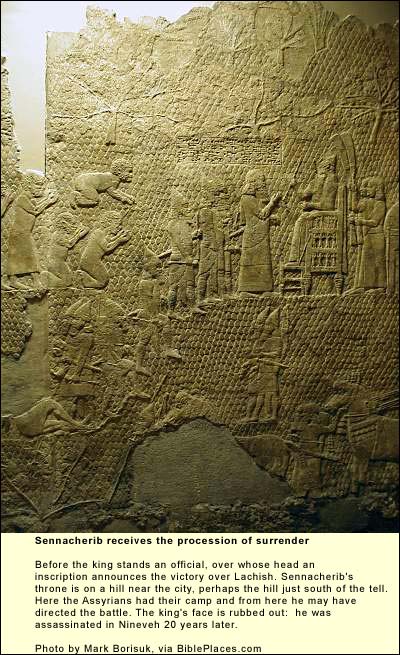
Excellent photographs of the Lachish reliefs, with detailed commentary, may be seen here and then here.
{mospagebreak title=The long aftermath}
The long aftermath of the battle at Lachish
Hezekiah's rebellion, the Assyrian response, and the survival of Jerusalem have helped make our world what it is.
1. The effect of Jerusalem's survival
The Assyrian policy was to disperse conquered exiles throughout the Assyrian realm, breaking up national identities. If this had happened to the Jerusalemites, there would have been no one to preserve the texts that became the First Testament. (Not the Samaritans: they first appear in the 4th century BC.) In 597 and 586 BC, when the Babylonians conquered Jerusalem, they followed a different policy, allowing exiles to remain in their national groups. These groups preserved the texts that became the Bible.
Returning to 701 BC: After Sennacherib devastated the Shephelah, Jerusalem was left "like a shelter in a vineyard, like a hut in a cucumber field, like a city under siege" (Isaiah 1:8). The kingdom shrank to an impoverished city and its mountain hinterland, where refugees had gathered. Hezekiah died in 686 and was succeeded by his son Manasseh (who had shared power with his father for the ten preceding years).
Manasseh kowtowed to Assyria, introducing its cults. The kowtowing led to economic revival. Although the Shephelah was lost, Manasseh took advantage of the pax assyriaca to develop industry and commerce in the Negev along the trade route from Arabia to the coast, as well as on the shore of the Dead Sea. His reign lasted an extraordinry 54 years. 2 Chronicles, a late 4th century work, explains his longevity and success as consequences of heartfelt repentance (2 Chron. 33: 10-17). But 2 Kings, written closer to his time, mentions no repentance; quite to the contrary, it attributes the Babylonian conquest of Jerusalem in 586 BC to the earlier "sins of Manasseh" (2 Kings 24:3).
Jerusalem's economic revival lulled Judahites into forgetting the years of misery that had followed Hezekiah's revolt. What stood out in memory, rather, was the fact that Jerusalem had survived the Assyrian onslaught. This fact engendered a belief that God would protect Jerusalem and the Temple, as expressed in Psalm 48: "Great is the Lord, and most worthy of praise, in the city of our God, his holy mountain….God is in her citadels; he has shown himself to be her fortress….God makes her secure forever …."
In the wider world meanwhile, in 664 BC, Ashurbanipal of Assyria conquered the northern part of Egypt. He'd overextended himself, and ten years later the Egyptians dislodged him. He was then forced to put down revolts on all fronts. By 638, when Manasseh's 8-year-old grandson, Josiah, became king of Judah, the Assyrians were tied up fighting against the newly rising Babylonians. They had ceased to be a vital force in Jerusalem.
During repairs to the Temple around 621 BC, a book of laws turned up. It was part of what we today know as Deuteronomy. On hearing its contents, Josiah undertook a religious reform (for which we have archaeological evidence). Now, in Deuteronomy it is written that if the people of Israel obeyed God's commandments they would prosper (for example, Deut. 11: 13-17). In line with this faith, Josiah undertook to enlarge and strengthen the kingdom. He built military bases to guard the ways to Jerusalem. In the devastated Judahite Shephelah, these included Azekah, Maresha, and Lachish.
But Josiah misread the political map. He seems to have thought that Assyria's withdrawal had left a vacuum. Yet Egypt was ambitious, and Babylon was rising. Egypt's policy was to use the vestige of the Assyrian army as a buffer against Babylon. When Pharaoh Neco II marched with his army through the mountain pass to Assyrian-held Megiddo in 609, Josiah "went toward him"—and was killed (II Kings 23: 29).
The event contradicted Deuteronomy: Here at last was a good king, and this had happened to him! The trauma of that death at Megiddo would lead to the prophecy of Armageddon ("the mountain of Megiddo" in Revelation 16:12-16) as the place where the injustice would at last be set right.
Enter Nebuchadnezzar of Babylon. In 604 he became master of the land bridge. Judah's King Jehoiakim acceded to his demand for tribute. But when Nebuchadnezzar failed to take Egypt, he looked weak, and the Judahite urge to sovereignty simmered again.
Despite the memory of Josiah's death, the century-old belief in God's defense of Jerusalem became a pillar in the platform promoting rebellion. Against this nationalistic monotheism of the pro-rebellion party stood universal monotheists, exemplified in Ezekiel and Jeremiah. They viewed Nebuchadnezzar as God's tool and came out against revolt. Ezekiel's actions in Ezekiel 4 and 5, convey the message that because of its sins, Jerusalem had lost divine protection until further notice (Ezekiel 21: 21-24 For the king of Babylon will stop at the fork in the road, at the junction of the two roads, to seek an omen: He will cast lots with arrows, he will consult his idols, he will examine the liver. Into his right hand will come the lot for Jerusalem, where he is to set up battering rams, to give the command to slaughter, to sound the battle cry, to set battering rams against the gates, to build a ramp and to erect siege works. It will seem like a false omen to those who have sworn allegiance to him, but he will remind them of their guilt and take them captive. “Therefore this is what the Sovereign Lord says: ‘Because you people have brought to mind your guilt by your open rebellion, revealing your sins in all that you do—because you have done this, you will be taken captive."). As for Jeremiah, his message went: "Do not trust in deceptive words like these: "The temple of Yahweh, the temple of Yahweh! The temple of Yahweh!" Instead do justice to the alien, the widow, and the orphan (Jeremiah 7:4-7). Prior to the revolt of 597, Jeremiah dictates his prophecies to Baruch, his scribe, who reads the scroll to the people gathered at the Temple. It is then brought to King Jehoiakim, who has it read aloud while he warms himself by the stove (it is December). After each three or four columns, the king has the scroll brought over, cuts the columns out and tosses them into the fire.
In response, the Lord bids Jeremiah: "Tell Jehoiakim king of Judah, 'This is what the Lord says: You burned that scroll and said, "Why did you write on it that the king of Babylon would certainly come and destroy this land and wipe from it both man and beast?" Therefore this is what the Lord says about Jehoiakim king of Judah: He will have no one to sit on the throne of David; .... I will bring on ... those living in Jerusalem and the people of Judah every disaster I pronounced against them, because they have not listened'" (Jeremiah 36:29-30).
After the death of Jehoiakim and the dethroning of his successor, Nebuchadnezzar installs the latter's uncle, Zedekiah, as king. Relying on the ideology of the pro-rebellion party, as well as Egypt, Zedekiah too withholds tribute, and once more the Babylonians besiege Jerusalem. Zedekiah sends officials to Jeremiah requesting an oracle. Recalling how Sennacherib had failed to take Jerusalem, they say to him (Jeremiah 21: 1-7):
"'…Nebuchadnezzar king of Babylon is attacking us. Perhaps the Lord will perform wonders for us as in times past so that he will withdraw from us.' But Jeremiah answered them, 'Tell Zedekiah, "This is what the Lord, the God of Israel, says: I am about to turn against you the weapons of war that are in your hands….."'" And a few verses later, to the people as a whole: "See, I am setting before you the way of life and the way of death. Whoever stays in this city will die by the sword, famine or plague. But whoever goes out and surrenders to the Babylonians who are besieging you will live; they will escape with their lives."
The pro-rebellion party condemned Jeremiah as a traitor (as he would no doubt be condemned today). They did not manage to have him killed, but they won the debate. Zedekiah revolted, and events unfolded as foretold. Toward the end, "the army of the king of Babylon was fighting against Jerusalem and the other cities of Judah that were still holding out—Lachish and Azekah. These were the only strongholds left in Judah" (Jeremiah 34:7). This biblical verse is echoed in the fourth of 21 letters discovered at Lachish in the form of ostracaPottery sherds with writing on them. It reads in part: "And he has been told that we are waiting for the fire signals from Lachish, according to all the instructions given by my lord. For we cannot see Azeqah." (Yadin's contrary theory.)Yigal Yadin proposed that the ostraca were drafts and that the final letters were written on papyrus and sent from Lachish. He translates the crucial passage in Ostracon 4 this way: "We are watching over (i.e., holding in readiness) the fire signals of Lachish." It is a question of whether the Hebrew word -el (normally meaning "toward") was sometimes confused with -al (meaning "over). At least five ostraca turned out to be sherds from the same jar. Most seem to have been addressed to one Ya-ush, perhaps the commander, and to have been sent by one Hoshaiah, an officer in a nearby base—maybe Maresha. From Maresha one can see Lachish, and as the letter says, one cannot see Azeqah (it is blocked by a hill 40 meters higher). On the other hand, from Lachish one could conceivably make out the beacons of Azeqah at night. Another ostracon speaks of sending to Egypt for aid. Still another quotes an unnamed prophet saying, "Be on guard!"
As Jeremiah had foretold, Jerusalem was conquered, the temple destroyed, and the upper-class survivors exiled. Yet despite the defeat, the faith that God would protect Jerusalem was destined to revival. Centuries after the Babylonian catastrophe, it persisted in the futile revolts against Rome, which were undertaken in the belief that God would intervene. Nor have we heard the last of this faith. It has a deep background, to be sure, in the Yahweh wars from the time before the monarchy, when circumstances were such that faith did indeed produce victory.
2. The emergence of the individual as the primary unit of existence in Judah
The spur to this subsection is Baruch Halpern in Halpern and Hobson, Law and Ideology in Monarchic Israel, JSOT Press, 1991.
Hezekiah's revolt and its catastrophic outcome had major effects. In the time before Hezekiah's revolt, kinship ties were strong – both "horizontally" through extended family, clan and village, and "vertically" through ancestry and posterity; a person did not experience his own being as that of an essentially distinct individual, but rather as a member of broader units. When confronted therefore with the question of divine justice – if God is just, why do the innocent suffer? – people could answer: "His ancestors must have sinned," or "Someone in his family or clan must have sinned."Such "corporate personality" was expressed in the proverb, "The fathers have eaten sour grapes and the children's teeth are set on edge."
However, when Hezekiah tore down local shrines and centralized worship in Jerusalem, rural kinship ties began to weaken. They weakened further when he brought the rural populations into the cities of Lachish and Jerusalem, thus depriving the Assyrian besieger of people to work the fields. The Assyrian conquest was the final straw. A Judahite survivor could no longer experience him- or herself primarily as a member of broader units. The main unit now was the individual in a nuclear family—though we should also add another unit: the state, as exemplified in Assyria. The old answer to the question of God's justice could no longer make sense in the new context. We hear this in Jeremiah 31: 29-30:
"In those days they shall say no more, The fathers have eaten sour grapes, and the children’s teeth are set on edge. But everyone shall die for his own iniquity: every man who eats the sour grapes, his teeth shall be set on edge."
The entire 18th chapter of Ezekiel is devoted to this transformation. Now the question of innocent suffering becomes much harder to answer. It is of course Job's question – scholars date the Book of JobFor a survey of views on the date of Job, see M. H. Pope, Job (Anchor Bible), New York, 1965, pp. xx-xxxvii. to a period after Hezekiah. The question will lead to new kinds of solutions: first, apocalyptic eschatology and later, a belief in divine justice after death.
In the world that has been influenced by the Bible, the larger sense of self - larger vertically through the generations, larger horizontally through the community - would never again have priority over the sense of the self as an individual, except in splinter movements.
{mospagebreak title=Tour of the Tell} A Tour of the Tell
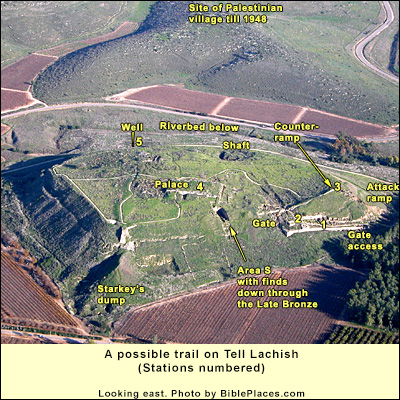
Leaving the siege ramp, we ascend the long, narrow access path to the city gate (#s 1 and 2 on the photo at right). Note that an army would have great difficulty here, strung out along the path and subject to spears and arrows from the city wall on our right. In the 9th- and 8th-century city there were in fact two walls, an upper one 6 meters thick, probably with crenellations so that soldiers could stand on it, and a lower wall, 3.5-4 meters thick, which held in place the steep artificial slope (glacis) that extended to the upper wall. Here too defenders could stand and fight. The building of such fortifications requires great resources in labor and material, no doubt beyond the means of local inhabitants. It requires a central authority, meaning a national state.
Present are the remains of gates from two different periods. There is the gate complex that the Assyrians destroyed in 701 BC, and there is one that the Babylonians destroyed when they took Lachish in 586. As we walk the modern ramp, we are roughly on the level of the access from 586. Before us (see photo below) are the remains of towers. On the left, the lower, bigger tower-base is from the 9th and 8th centuries, the higher from the 6th. On the right we see part of the restored tower from the 6th. Entering between them, we find ourselves in a normal-sized courtyard. It is from 586, but the 9th-8th century courtyard was much bigger - enormous in fact - as you can see in the photo below.
Inside the eastern tower from the 6th century, James Starkey and colleagues found 21 ostracaPottery sherds with writing on themfrom the final, catastrophic revolt against Babylon. (See the previous section.) What were the letters doing in the gate? Lachish was then a thinly settled affair. The 9th-8th century palace remained in ruins. It is possible that the local commander, Ya-ush, converted the outer gate into his headquarters.
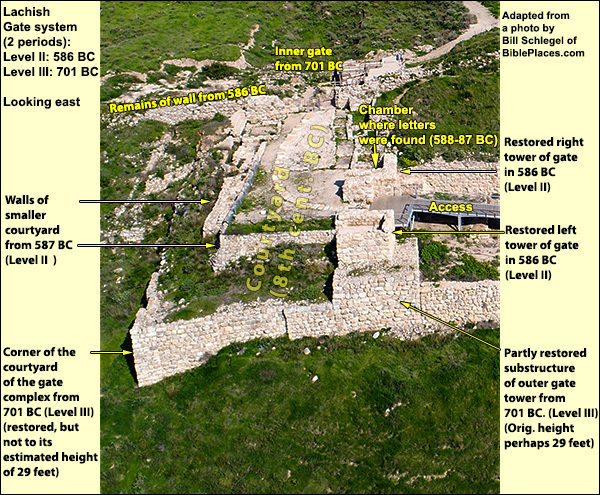
We go east through the courtyard and through an opening to the inner side of the city wall. Here we find traces of the inner gate from the 8th century BC. The chambers on the left (north) were excavated in the 1930's, but those on the right were exposed quite recently. As of this writing (Februry 2018), they are covered with a wooden structure, pending the full opening of the Lachish National Park. In the SW chamber (see photo below) Saar Ganor and his co-workers discovered stone benches facing each other, so close that if a judge ate onions for breakfast, his colleagues on the opposite bench could not but be aware. This is a curious arrangement, for the benches we know from Dan and (so-called) Bethsaida were in the courtyard between the outer and inner gates, allowing sufficient space for a trial. The 8th century Lachish gate-complex boasted a huge courtyard, as we have seen. Why then were the benches not in it? Well, perhaps there were also benches there and they were plundered.
In First Testament cities, the gate could function as a court of law, especially for cases involving (1) the tenth of the local population that lived inside the city and (2) the nine-tenths who lived in surrounding villages, farming the land. The names of some cities reflect this: Gezer was a place of judicial decision (gezira), Megiddo a place where verdicts were spoken (magid), Dan a place of judgement (dan). The Bible offers examples of judicial process in the gate: for example, Abraham's negotiation to buy a burial place for Sarah (Genesis 23), Boaz's purchase of the right to marry Ruth (Ruth 4:1), the place for bringing a complaint that could end in execution (Deut. 21:19; 22:15). But the gate was also a place of commerce. The farmers brought the fruits of their labor to the city: for instance, huge quantities of grain were found in the gate chambers of e-Tel ("Bethsaida"). It was one of the judges' functions to decide on and proclaim (again magid, etc.) the value of products. Each city would have had its own rate: the word for "currency rate" in modern Hebrew is derived from the biblical word for gate, sha'ar, as in this example:
Elisha replied, “Hear the word of the Lord. This is what the Lord says: About this time tomorrow, a seah of the finest flour will sell for a shekel and two seahs of barley for a shekel at the gate (sha'ar) of Samaria.” (2 Kings 7:1).
In the southeast chamber of the inner 8th-century gate, Ganor found a platform and two altars whose horns had been deliberately damaged - likely a result of Hezekiah's reform, which included the destruction of cultic places outside Jerusalem (2 Kings 18:1-6)"He did what was right in the eyes of the Lord, just as his father David had done. He removed the high places, smashed the sacred stones and cut down the Asherah poles....He held fast to the Lord and did not stop following him; he kept the commands the Lord had given Moses. And the Lord was with him; he was successful in whatever he undertook. He rebelled against the king of Assyria and did not serve him.. This particular cultic place was further desecrated by placement upon it of what seems to have been a thick stone toilet seat, with an opening in the shape of a keyhole. (No sign of excrement was found beneath, however.) Recall what Jehu did in Yahweh's name after killing the sons of Ahab in the city of Samaria: “Then they demolished the pillar of Baal, and destroyed the temple of Baal, and people have used it as a latrine to this day” (2 Kings 10:27).
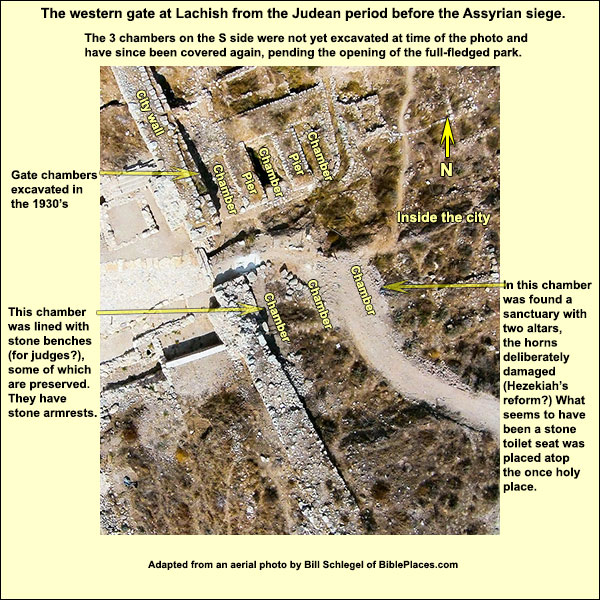
We climb a trail southward to the rim of the tell overlooking the assault ramp. Here the diggers discovered a Judahite counter-ramp (see the photo on the right.) Below us was the conjunction of the city's upper wall with the lower wall, the two here forming a kind of tower. Standing on the counter-ramp and looking down, we can re-create the story that is told in the reliefs, but this time from the defenders' point of view: how they braved the Assyrian archers, throwing torches on the chariots and stones, trying to "hook" the big spears of the chariots to overthrow them, setting their own useless chariots on fire and hurling them down.
The position also affords our first good look around. We can make out the smokestacks of modern Ashkelon and Ashdod to the west. Ten miles to the north is Gath (Tell es-Safi). To the east we can see Maresha and beyond it Judah's mountain, where the valley-pass from Hebron comes down to join the valley-pass just under us on the southeast. Here again is the satellite photo:

Descending from the counter-ramp, we follow a trail north to the palace. Only its podium remains: a raised platform 76.5 meters long, 32 wide and today more than 11 meters high on the southwest corner. We should probably envision another 4 meters or so in height to approximate the original. The enlargeable photo on the right conveys an idea of the palace-fort's area in relation to the rest of the tell.
The podium was constructed in two phases. The earlier (dubbed Podium A) was a 31.5 meter square built of ashlars on the north end (outlined in red below). The number works out to 60 royal Egyptian cubits (20.6 inches each), so this must have been the unit of measurement. The contrasting southern portion, built of rough stones, is 45 meters in length, which works out to 100 short cubits (18 inches each). It is outlined in dark blue.
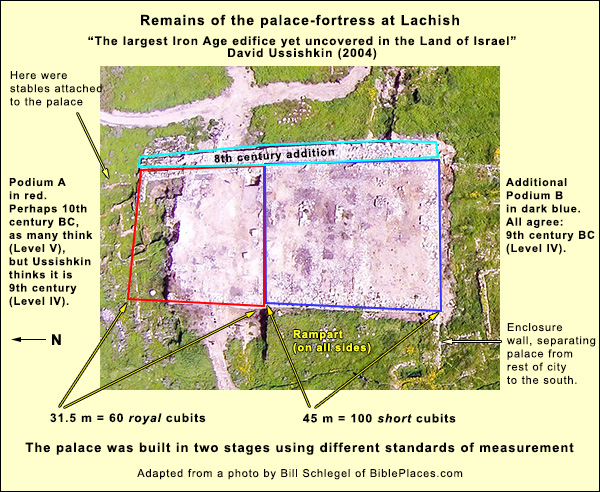
Given the different materials and units of measure, many believe that Podium A belonged to a palace-fort of the 10th century (Level V), and that Podium B was added in the 9th (Level IV) to enable an expansion. Ussishkin disputes this, because he found Level-V material beneath Podium A. If this podium also belonged to Level V, he argues, then it would have had two phases at this spot; nowhere else on the tell, however, does it show more than a single phase.
Anticipating the arrival of Assyria, the inhabitants may have strengthened the palace-fort in the 8th century, but the only sign of this today is a piece of long wall on the east side, added then. In that century, too, the palace had a large courtyard with its own multi-chambered gate, as can be seen in the photo below. A row of stables attached to its north end suggests that the courtyard was a parade- and training-ground for horses and chariots, as at Megiddo. Fragments of many storage jars from Hezekiah's time were discovered in the south side. There was also much burnt brick.
Remarkably, the 6th-century Judahites did not rebuild the palace - lack of funds perhaps - and the presence of the Lachish letters in the gate suggests that the commander decided to improvise his headquarters there instead.
The column bases on the podium stem from a residence or administrative center of the Persian period (538-332 BC).
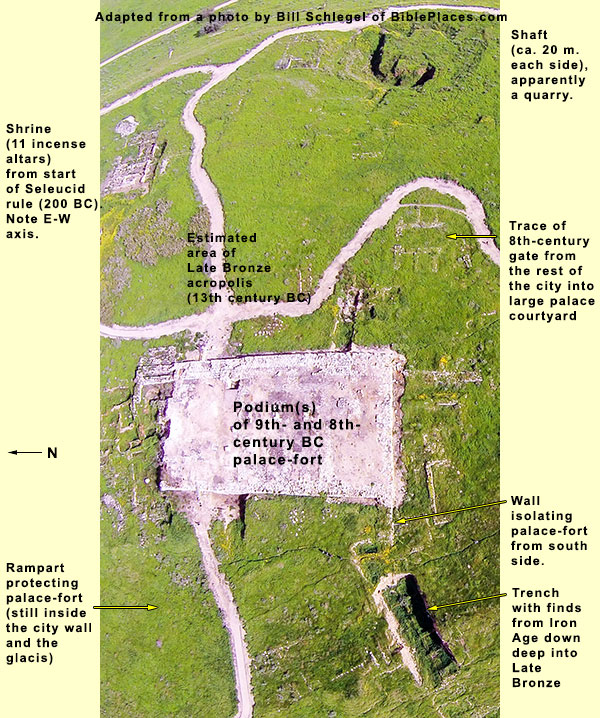
Around the northern perimeter to the well
We take a trail around the northern rim of the tell to its northeast side, where Yosef Garfinkel recently discovered a wall dated to around 920 BC [See update].
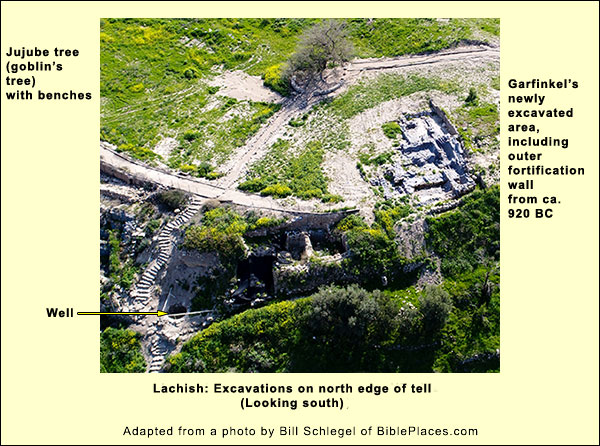
In the shade of a lone jujube some benches are arranged. The trail leads to a point where we descend a few yards (carefully) to the opening of a well.
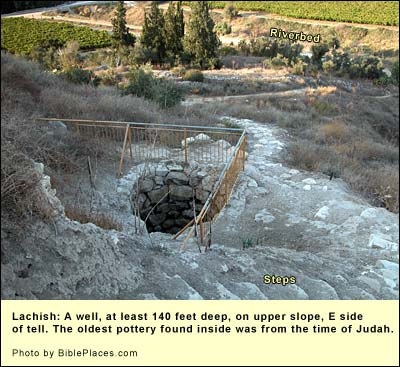
This was the main water source, at least from the time of Judah. (No earlier pottery was found in the well.) According to Ussishkin, it was protected by the lower of the city's two walls. Like all Shephelah towns, Lachish lacked a spring (as explained in the introduction, rainwater cannot penetrate the top layer of chalky limestone). We can see a riverbed, though, beneath us. It cuts through the surface limestone, so water could penetrate downward there until stopped by a waterproof layer of rock. Those who dug the well knew they had to reach the water that had collected in the area of the riverbed. This required an extraordinary depth of at least 44 meters. Until 1948, it was the only water source for the families of Palestinian Al-Qubayba below. They used to send their children up with buckets. Not wanting them to linger, they warned about a goblin in the jujube.
At present (2018), the trail ends here. Either we can descend the rest of the steps to the east side of the tell and then walk north beside the wadi to a road where the bus can wait, or we can return by the way we came.
{mospagebreak title=Logistical note}
Logistical Note The site is a National Park, but as of April 2018 there is no entrance fee, no opening hours are posted, and there are no rest rooms. This may soon change. A Visitors Center is being built. Already the paths are well laid-out and marked, but there is still a good deal of plant growth between them. For this reason it is advisable to wear long pants and walking shoes. The only shade is at the jujube tree, so one should also have a hat and plenty of water.